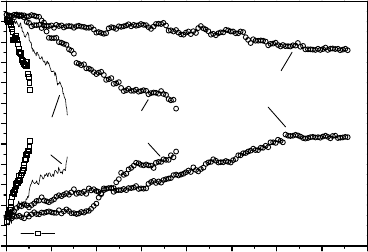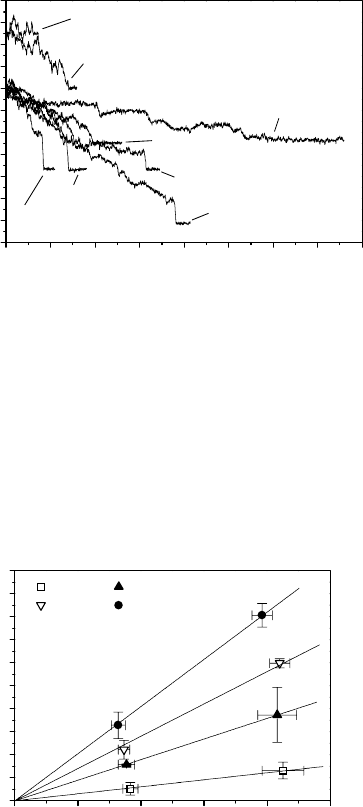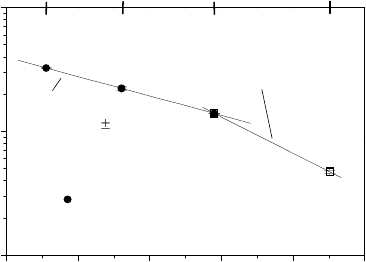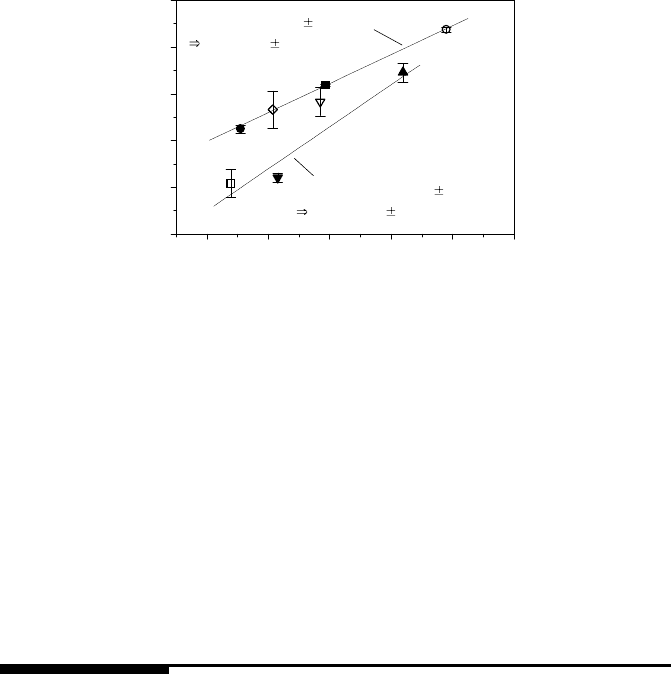Gottstein G., Shvindlerman L.S. Grain Boundary Migration in Metals: Thermodynamics, Kinetics, Applications
Подождите немного. Документ загружается.


476 5 Computer Simulation of Grain Boundary Motion
The distinction between high-angle and low-angle GBs was captured in the
simulations, as evident from the GB migration activation parameters. The
GB migration activation enthalpy for the two true low-angle twist GBs, Σ41
and Σ85, was about 0.12eV. As confirmed in the simulations, the low-angle
twist GBs consist of discrete screw dislocation networks that remain stable
throughout the studied temperature range. Hence, the migration mechanism
of the low-angle twist GBs must be linked to a movement of the screw dislo-
cation network itself. By contrast, the high-angle twist GBs can move in the
low temperature regime by collective shuffle mechanisms [522, 537] which are
usually in-plane rearrangements. At elevated temperatures, an out-of-plane
component of the atomic displacement appears which might be the cause for
a change of the GB migration mechanism as reflected by the drop of the GB
mobility above 900 K.
Using the OCDF as the DF concept for the studied twist GBs yields identi-
cal results for the GB mobility [524], the activation parameters of GBM [524]
as well as for the found GBM mechanism [524].
5.4 Motion of Tilt Boundaries
While the application of an elastic strain on the simulation box worked suc-
cessfully to drive a twist boundary, it failed for tilt boundaries [524]. This is
due to the fact that the application of any stress or strain state necessary to
yield an elastic DF to a tilt boundary whose structure is composed of edge
dislocations invariably caused GB sliding in addition to GB migration [524].
This eventually will stall GB migration and, therefore, renders MD simula-
tions of GB migration unsuccessful [524]. These deficiencies can be overcome
by the use of an OCDF.
All simulations of the migration of Σ5, 53.13
◦
[001] tilt boundaries were
obtained by MD simulations utilizing the Doyama EAM potential and by ap-
plying 3D periodic boundary conditions.
The studied GB system consisted of 100 (210) planes, where initially 60
(210) planes belonged to the lower grain and 40 (210) planes to the upper
grain. Eight (002) planes were stacked in x-direction and the overall number
of atoms was 4800. The relaxed GB energy was 0.899 J/m
2
. The interatomic
distance of (210) planes was 0.2236068 a
o
.
Finite temperature simulations were performed where only the h
33
box
variable was allowed to adjust to the present stress state according to the
Rahman-Parrinello scheme. Under this constraint for the simulation box it
was found that indeed the Σ5 (210) tilt GB can move continuously in the
presence of an OCDF. Two examples of GB position vs. time profiles are
© 2010 by Taylor and Francis Group, LLC

5.4 Motion of Tilt Boundaries 477
0 500 1000 1500 2000
-50
-40
-30
-20
-10
0
10
GBM at 800 K with orien.-corr. DF
0.00197 eV/atom
0.00197 eV/atom
0.00462 eV/atom
Σ 5 [001] 53.13° sym. tilt GB
Doyama EAM with 3D per. BC
and adjustable h
33
component
GB Position [10
-10
m]
t [ps]
box
FIGURE 5.14
GB position profiles at 800 K of the Σ5 (210) symmetrical tilt GB with ad-
justable h
33
box variable and OCDF.
shown in Figs. 5.14 and 5.15. At 800 K and low DF the GBs hardly move at
all, but at high DFs they move quite rapidly. From a linear regression of the
displacement vs. time dependencies the GB velocities of GB
1
and GB
2
were
obtained and averaged. They are plotted in Fig. 5.17 vs. the OCDF, p
corr
.
A large error reflects the occasional case that one GB moved while the other
one remained essentially sessile. The DF was usually imposed on the system
in such a way that in the lower grain A a higher excess energy was installed
than in the upper grain B, which led to the shrinkage and disappearance of
grain A.
The GB mobility was determined from the slope of the GB velocity
vs. OCDF plots (Fig. 5.17). An Arrhenius plot (Fig. 5.18) yielded the ac-
tivation parameters of GB migration. The activation enthalpy found for the
Σ5 boundary was Q =0.64±0.04 eV and the pre-exponential factor m
0
=
4.2·10
−8
[m
4
/Js].
It was already observed for MD simulations with imposed elastic stress [524]
that for the Σ5 (210) tilt GB during GB sliding and migration GB diffusion
was necessary to reconstruct the GB structure. Hence, it does not come as
a surprise that the Σ5 (210) tilt GB can move by a diffusion-controlled or
diffusion-assisted mechanism that is not coupled to GB sliding. If the h
22
,
h
23
, h
32
and h
33
box variables remained adjustable this enforced GB sliding.
For such a case Fig. 5.19 presents GB position vs. time profiles at 800 K and
1100 K whereas Fig. 5.20 shows the temporal evolution of the strain compo-
nent ε
YZ
for all simulations conducted. An analysis of the ε
YZ
profiles proved
that under the studied boundary conditions for the simulation box GB sliding
and GB migration were coupled. The data show that the higher the temper-
© 2010 by Taylor and Francis Group, LLC

478 5 Computer Simulation of Grain Boundary Motion
0 20406080100120140160180
-50
-40
-30
-20
-10
0
10
Doyama EAM with 3D per. BC and adjustable h
33
Σ
5 [001] 53.13° sym. tilt GB
0.00399 eV/atom
0.00166 eV/atom
GBM at 1100 K with orien-corr. DF
GB Position [10
-10
m]
t [ps]
FIGURE 5.15
GB position profiles at 1100 K of the Σ5 (210) symmetrical tilt GB with
adjustable h
33
box variable and OCDF.
0 20 40 60 80 100 120 140 160 180
-2
-1
0
1
2
3
4
5
Doyama EAM with
3D per. BC
and adjustable h
33
Σ
5 [001] 53.13° sym. tilt GB
Orien.-corr. DF proles at 1100 K
p
corr
[0,001 eV/atom]
t[ps]
FIGURE 5.16
OCDF profiles at 1100 K of the data presented in Fig. 5.15. The observed
decline of the DF occurs close to the annihilation of the two GBs in a system
where 3D periodic BC are applied.
© 2010 by Taylor and Francis Group, LLC

5.4 Motion of Tilt Boundaries 479
012345
0
2
4
6
8
10
12
14
16
18
20
Σ
5 [001] 53.13° symm. GB
Doyama EAM with 3D per. BC and h
33
800 K 900 K
1000 K 1100 K
<v
GB
> [m/s]
p
corr
[0,001 eV/atom]
adjustable
FIGURE 5.17
Average GB velocity vs. OCDF of the Σ 5 (210) symmetrical tilt GB with
adjustable h
33
box variable at 800 K to 1100 K.
10 11 12 13 14 15
1
10
100
1100 K
Q
GBM
= 0,64 0,04 eV
m
GBM
(0) = 42270 [10
-8
m
4
/ Js]
Σ
5 [001] 53.13° sym. tilt GB
Doyama EAM with 3D per. BC,
adjustable h
33
box component and
orien.-corr. DF
800 K
900 K
1000 K
m
GB
[10
-8
m
4
/ Js]
1/k
B
T [1/eV]
FIGURE 5.18
Arrhenius plot of GB mobility of the Σ5 (210) symmetrical tilt GB with
adjustable h
33
box variable and OCDF.
© 2010 by Taylor and Francis Group, LLC

480 5 Computer Simulation of Grain Boundary Motion
0 200 400 600 800 1000 1200 1400 1600
-50
-45
-40
-35
-30
-25
-20
-15
-10
-5
0
5
10
EAM with 3D per. BC
and h
22
,...,h
33
adjustabl e
Σ 5 (210) sym. tilt GB
1100 K - 0,00392 eV/atom
1100 K
0,00164 eV/atom
800 K
0,00425 eV/atom
800 K
0,00183 eV/atom
GB Position [10
-10
m]
t [ps]
FIGURE 5.19
GB position vs. time plots of the Σ5 (210) symmetrical tilt GB with adjustable
h
22
,...,h
33
box variables and OCDF at 800 K and 1100 K.
ature the lower the accumulated ε
YZ
strain.
The 900 K data revealed that for different magnitudes of the OCDF at
one temperature, the accumulated ε
YZ
strain was still the same. This was
not found for all temperatures. The decrease in ε
YZ
with increasing temper-
ature can be understood from a change in the mechanism from a coupled GB
sliding and migration mechanism to a more diffusion-controlled GB motion
mechanism. This underlines that with increasing temperature a change in GB
character occurs for this GB. The average GB velocity vs. OCDF at different
temperatures is shown in Fig. 5.21, and an Arrhenius plot of the temperature
dependence of the GB mobility is given in Fig. 5.22.
The results appear slightly different from the results of the simulations with
only an adjustable h
33
box variable. First of all, the obtained GB velocities
of GB
1
and GB
2
of a single simulation run agree much better as manifested
by the relatively small error bars compared to Fig. 5.17. Second, the average
GB velocity vs. OCDF plots were almost perfectly linear which was not ob-
served to the same degree for the simulations with only an adjustable h
33
box
variable. This substantiates that GB migration of the Σ5 (210) tilt GB pro-
ceeds by coupled GB sliding and migration. The data imply a change of GB
mechanism with increasing temperature which is reflected by the two regime
fit of the GB mobility data. Since the error bars of the GB mobility data are
© 2010 by Taylor and Francis Group, LLC

5.4 Motion of Tilt Boundaries 481
0 200 400 600 800 1000 1200 1400 1600
-0,14
-0,12
-0,10
-0,08
-0,06
-0,04
-0,02
0,00
0,02
0,04
0,06
0,08
1100 K
0,00392 eV/atom
1100 K
0,00164 eV/atom
1000 K
0,00173 eV/atom
1000 K
0,0042 eV/atom
900 K
0,00416 eV/atom
Σ 5 (210) sym. tilt GB
900 K
0,00177 eV/atom
800 K
0,00183 eV/atom
800 K
0,00425 eV/atom
EAM with 3D per. BC
and h
22
,...,h
33
adjustable
ε
YZ
[1]
t [ps]
FIGURE 5.20
Temporal evolution of the strain component, ε
YZ
, obtained by simulations
of the Σ5 (210) symmetrical tilt GB with adjustable h
22
,...,h
33
box variables
and OCDF.
012345
0
2
4
6
8
10
12
14
16
18
20
Σ
5 [001] 53.13° symm. GB
EAM with 3D per. BC and h
22
,..,h
33
adjustable
800 K 900 K
1000 K 1100 K
<v
GB
> [m/s]
p
corr
[0,001 eV/atom]
FIGURE 5.21
Average GB velocity vs. OCDF of the Σ5 (210) symmetrical tilt GB with
adjustable h
22
,...,h
33
box variables and OCDF from 800 K to 1100 K.
© 2010 by Taylor and Francis Group, LLC

482 5 Computer Simulation of Grain Boundary Motion
10 11 12 13 14 15
1
10
100
Low T regime
Q
GBM
= 0,67 eV
m
GBM
(0) = 83832 [10
-8
m
4
/ Js]
1100 K
High T regime
Q
GBM
= 0,36 0,001 eV
m
GBM
(0) = 1456 [10
-8
m
4
/ Js]
Σ
5 [001] 53.13° sym. tilt GB
Doyama EAM with 3D per. BC,
adjustable h
22
,...,h
33
box component
and orien.-corr. DF
800 K
900 K
1000 K
m
GB
[10
-8
m
4
/ Js]
1/k
B
T [1/eV]
FIGURE 5.22
Arrhenius plot of GB mobility of the Σ5 (210) symmetrical tilt GB with
adjustable h
22
,...,h
33
box variables and OCDF.
very small, the data seem reproducible, and a true low temperature and high
temperature regime for GB migration do exist.
Comparing the GB mobility data obtained by the simulations with only the
adjustable h
33
box variable and adjustable h
22
,...,h
33
box variables (Fig. 5.23)
reveals very good data agreement between both data sets. It is interesting to
note that out of all data points, the 800 K data points give the poorest match.
This again supports the interpretation that due to different simulation box
boundary conditions, ideal GB migration was hindered in the low tempera-
ture simulation runs with only one adjustable h
33
box variable. To elucidate
the thermally activated processes of the Σ5 [001] 53.13
◦
symmetrical tilt GB,
the results of GB self-diffusion [524] (GBD) and GB migration of this GB are
listed in Table 5.4. For the simulation results with only adjustable h
33
and
the low temperature regime of the simulations with adjustable h
22
, h
23
, h
32
,
and h
33
, the GB migration enthalpy and the GB self-diffusion enthalpy are
the same. For the simulation results with only adjustable h
33
, this finding and
the non-occurrence of GB sliding events demonstrate that under such simula-
tion box constraints, this tilt GB can move by a mechanism not accompanied
by GB sliding. At higher temperatures for the simulations with adjustable
h
22
, h
23
, h
32
and h
33
, the GB migration mechanism changes according to the
found GB migration activation parameters where the activation enthalpy of
migration becomes about half of the activation enthalpy of GB self-diffusion.
This ratio of approximately two between the enthalpy for GB self-diffusion
and GB migration was found as well for the studied high-angle [001] twist
GBs [524, 527]. For the simulations with adjustable h
22
, h
23
, h
32
and h
33
,GB
migration and GB sliding are coupled although the grain boundary strength
© 2010 by Taylor and Francis Group, LLC

5.5 Compensation Effect 483
10 11 12 13 14 15
1
10
100
1100 K
Σ 5 [001] 53.13° sym. tilt GB
EAM with adjustable h
33
EAM with adjustable h
22
,...,h
33
800 K
900 K
1000 K
m
GB
[10
-8
m
4
/ Js]
1/k
B
T [1/eV]
FIGURE 5.23
Arrhenius plots of GB mobility of the Σ5 (210) symmetrical tilt GB for ad-
justable h
33
box variable and adjustable h
22
,...,h
33
box variables.
TABLE 5.4
GB Migration and GB Self-Diffusion [524] Activation Parameters of the
Studied Σ5 [001] 53.13
◦
Symmetrical Tilt GB Using EAM Potentials
m
GBM
(0) Temp.
GB
1
Q
GBM
[eV] [10
−8
m
4
/Js] regime Q
GBD
[eV]
δ·D
GB
(0)
Ω
[
1
ps
]
Σ5 (210) 0.64±0.04 42270 One 0.59±0.05 11.477
Σ5 (210) 0.67 83832 Low
0.36 1456 High
Note: The listed GB migration activation parameters are associated
with the orientation-correlated DF.
1
GBM data obtained by simulations with adjustable h
33
component.
decreases steadily with increasing temperature.
5.5 Compensation Effect
The obtained activation parameters of the studied [001] twist GBs were also
analysed with respect to the compensation effect [389]. The standard compen-
sation effect analysis [389] of the [001] twist GB data is given in Fig. 5.24 where
the GB migration enthalpy is plotted vs. the logarithm of the pre-exponential
factor of GB mobility yielding the compensation temperature T
c
according to
© 2010 by Taylor and Francis Group, LLC

484 5 Computer Simulation of Grain Boundary Motion
Q
GBM
= α + β ·ln(m
o
)withβ = k
B
T
c
. Physically speaking the compensation
temperature is considered to be the equilibrium temperature between ground
state and activated state [389], here for the mechanism of GB migration.
Two data sets seem to exist that are associated with either low-angle or
5678910
0,0
0,1
0,2
0,3
0,4
0,5
Σ
17
Σ
5
Σ
13
Σ
41
Σ
85
Σ
29
at high T
Σ
25
Σ
29
at low T
Slope : 0,09003 eV 0,020 eV
T
C
= 1045 232 K
Slope : 0,06199
0,005 eV
T
C
= 720 58 K
Q
GBM
[eV]
ln (m
0
[10
-8
m
4
/Js] )
FIGURE 5.24
Compensation plot of the GB migration activation parameters of the studied
[001] twist GBs.
high-angle [001] twist GBs. The compensation temperatures T
C
found seem
realistic. It is especially interesting that the low-angle twist GBs have a rather
high T
C
compared to the high-angle GBs, actually close to the melting tem-
perature. The lower T
C
for the high-angle twist GBs indicates structural tran-
sitions in the boundary as, for instance, observed for the Σ29 twist GB.
5.6 Comparison with Experiments
Winning [521] studied the motion of planar [001] low- and high-angle tilt and
twist GBs in Al driven by a Peach-Koehler driving force. Although the studied
GBs were non-CSL GBs, the experimental data lend themselves to a compar-
ison. It was observed experimentally that high-angle curved tilt GBs had a
rather high GB migration enthalpy compared to the same planar tilt GBs.
Furthermore, it was found that planar [001] tilt GBs had a higher activation
enthalpy than [001] twist GBs. Finally the level of purity of a studied GB sys-
© 2010 by Taylor and Francis Group, LLC

5.7 Grain Boundary Diffusion 485
tem determined to some extent the magnitude of the GB migration activation
enthalpy. A comparison of the data by Winning [521] and the computed data
of this work reveals that the GB migration enthalpies of the high-angle GBs
are in a comparable range. Knowing that the bulk self-diffusion enthalpy is
1.29eV in Al and 2.01eV in Cu, the expected experimental activation data of
a Cu material would be about 35 percent higher than the Al data assuming a
simple scaling behavior. In the low-angle regime, the data agreement is poor.
The difference might be due to purity effects. The computed low-angle GB
migration behavior represents the motion of a screw dislocation network in
an absolutely pure material which may explain the extremely low activation
enthalpies.
5.7 Grain Boundary Diffusion
5.7.1 Computational Procedure
The temporal evolution of the mean-square displacement (MSD) of atoms can
be used to determine the diffusion coefficient D of various diffusive processes
in atomistic systems.
The calculation scheme is based on the mean-square displacement (MSD)
contribution of GB atoms arising from GB self-diffusion. Usually, rather re-
stricted atomic systems have been used to study GB self-diffusion [531]–[533]
to suppress GB sliding. It is a common experience that GB sliding occurs
under 3D periodic boundary conditions. However, GB sliding, GB migration
and GB self-diffusion are conceived always to occur simultaneously. Hence,
in order to study real material behavior GB sliding should not a priori be
suppressed.
Since GB sliding occurs during almost every conducted GB simulation, a
refined analysis of atomic displacements is necessary to determine only the
diffusive GB MSD. Usually, every 1000 time steps the position of each atom
within the system is stored to be analyzed subsequently. Hence, the data anal-
ysis on atomic configurations is performed in time steps of usually 1.84 ps.
The analysis procedure itself works in two steps. In step one at time t the
common neighbor analysis (CNA) method is used to classify atoms either as
true fcc atoms or not. Any true fcc atom is excluded from the GB MSD anal-
ysis at time t and its instantaneous position is kept as the reference position
for the following analysis at t+δt. Non-fcc atoms are evaluated for calculating
the diffusive GB MSD. In order to separate GB sliding displacements from
GB self-diffusion data, a threshold displacement of 0.35a
o
is used. Any GB
atom having a displacement less than 0.35a
o
between t−δtandt is considered
non-diffusive and does not enter the calculation of the diffusive GB MSD at
time t. Its position at time t is kept as the reference position for the following
© 2010 by Taylor and Francis Group, LLC
